Another preface before I start the article proper: This article is going to focus on individual card design instead of set design. I have little experience in set design, as making a set is a long-term project and I don’t make any money doing this (although I wish I did, if you’re reading this MaRo, I’m always available!). Also, this article will focus more on the mechanical side of design, with flavor being an important part of design, but flavor should never take a back seat to function.
If you’ve ever designed more than fifty cards, skip this paragraph. The rest of you, pay attention very closely. The first thing you want to do, before ever firing up Notepad and typing anything in, is to question your motives. “Why do you want to design cards?” If you think that a card has to be good in order for it to be good card design, or if you make cards that would be good in your deck, pay as close attention as possible, because you’ll get a new perspective of card design. I prefer to design cards realistically, as though they could possibly see print in an actual set. One of my favorite compliments to be received as a card designer is to be asked "Is that card real?", even though it is not intended to be a compliment.
The Joys of Simplicity

Too many abilities and not enough
payoff makes baby Homarid cry
Serra Harrier –
Creature – Angel (U)
Flying, flash
When Serra Harrier comes into play, tap target creature.
If a spell or ability an opponent controls would cause you to discard cards, instead you gain that much life.
: All creatures lose deathtouch until end of turn.
2/3
This is an example of "too many ability syndrome". This card has two or three cards worth of material on one card. This is bad because players don’t like to read walls of text. It’s also overcosted chaff, which is what killed Onslaught and Kamigawa blocks for me. There was a severe difference in power between the commons and the rares. Anyway, I can make three cards out of this one. If I was interested in making a set, that’s just three holes I’ve filled. If I wasn’t interested in making a set, that’s two more cards I don’t have to worry about making to fill up my daily post. How would I fix this?
Serra Harrier –
Creature – Angel (U)
Flying, flash
When Serra Harrier comes into play, tap target creature.
2/3
Pure at Heart –
Enchantment (R)
If a spell or ability an opponent controls would cause you to discard cards, instead you gain that much life.
Fearless Recruit -
Creature -- Human Soldier (C)
Whenever Fearless Recruit blocks or becomes blocked by a creature with deathtouch, that creature loses deathtouch until end of turn.
2/2
Serra Harrier is a card I would windmill slam in limited, Pure at Heart is an effective hoser, and Fearless Recruit is a good common in a set that for some reason has a ton of basilisks and poison-tip archers. Even if it never encounters one, it is still a 2/2 for :1mana::symw:. Why did I change the original Harrier’s activated ability into a free trigger and stick it onto an efficiently-costed creature? That will be explained in a bit, but let me lead into it with the dangers of designing narrow cards.
Make Cards That Can Be Used
Don’t make cards that are too narrow. Well, let me rephrase that, because WOTC often makes cards that are narrow. Don’t make cards that are dead too often, with no way of playing it effectively, or playing it at all, or that have no effect on the board if it is played without the perfect situation. Let me give you a new example before going back to Harrier and Recruit:
Tivadar's Meditation -
Enchantment (U)
Whenever a Goblin comes into play under another player's control, you gain 2 life.
This is another bad card that I designed to prove a point. This is a Goblin hoser, but it will never see any play in any Vintage, Legacy, or Extended sideboard, ever. Why is that? Well, for one reason, it costs four mana. Goblins should kill you before you get to four mana. Also, Goblins has insane damage potential, so even if you got this card out before Goblins killed you, it wouldn’t matter, as Goblins would have more than enough damage potential to kill you. How can I fix this card?
Soothing Meditation –
Enchantment (U)
Whenever a red creature comes into play under another player’s control, you gain 2 life.
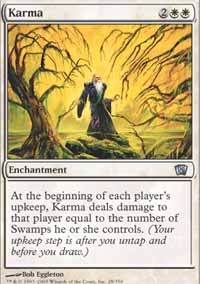
Karma: A pain for MBC
from 8th to 9th
Also, if you absolutely have to make a narrow card, remember there are mechanics out there at your disposal. Cantripping (the “Draw a card” at the end of some spells), cycling, landcycling, forecast, and buyback are some examples of ways to give your card pizazz and prevent players from feeling left high and dry too many times while using it.
Now, back to the original Serra Harrier and the Fearless Recruit that spawned from it. The original Harrier was an overcosted creature hampered by abilities that are worthless in most board positions. But how did I get from ": All creatures lose deathtouch until end of turn." to "Whenever Fearless Recruit blocks or becomes blocked by a creature with deathtouch, that creature loses deathtouch until end of turn."?
Deathtouch is a very narrow ability. In fact, unlike the other timeshifted “basic” abilities (lifelink, shroud, reach), no other creatures were changed to include Deathtouch. Thornweald Archer is a very good card, but not worth paying every turn to make it stop firing deadly arrows at your Durkwood Baloth. But what if I make the ability cost nothing and paste it on an efficient body? (No matter how many times WotC makes cards strictly better than Grizzly Bears and Knight Errant, a 2/2 body for 1C is still very efficient, and you can’t have too many 2/2 creatures for 2 mana or you run the risk of making limited too fast.)
The Color Pie
The third thing that inexperienced card designers tend to do is to disrespect the color pie. Disrespecting the color pie is all the rage now (even WotC is doing it). Normally I wouldn’t make that big of a point over it, but new players and card designers need to realize that Time Spiral block isn’t a radical shift in philosophy for WotC, but simply a new way of looking at the color pie. WotC has strongly upheld the color pie before Time Spiral block and will continue to uphold it in Lorwyn and beyond. For those of you that don’t recognize the color pie, here’s a short summary of the abilities allowed each color:
White – Life gain, lifelink, destruction of enchantments and sometimes artifacts, destruction and damage to attacking and blocking creatures, damage prevention, damage redirection, tapping, first strike, flying, vigilance, efficient weenies, +0/+X, +1/+1, taxing, protection, making your opponent want to slug you in the face.
Blue – Flying, countermagic, bounce, card draw, card quality, instants, permanent stealing, -X/-0, milling, color and type hacking, tapping and untapping, shroud, artifact tutoring, forking, flash, making your opponent want to slug you in the face.
Black – Life drain, fear, paying life for improved spells, tutoring, killing creatures outright, -X/-X, destroying lands, searching libraries for cards and removing them from the game, discard, spells that scale for number of Swamps you control, making opponents lose life, regeneration, removing cards from the graveyard from the game, deathtouch.
Red – Burn, haste, first strike, temporary theft of creatures, creatures that are removed from play at end of turn, randomness, destruction of lands and artifacts, +X/+0, +X/-X, temporary mana, preventing regeneration, preventing damage prevention, uncounterability, target-changing.
Green – Mana fixing, acceleration, land search, efficient creatures, trample, +X/+X, +1/+1 counters, shroud, regeneration, creature-based card draw, land destruction, artifact and enchantment destruction, uncounterability, untapping (creatures and lands), deathtouch, reach, flash.
If I forgot anything, it’s most likely an oversight, as the colors are very deep. The color pie is essential to the game remaining viable as it creates a reason and a philosophy for each color. Cards such as the following should not exist:
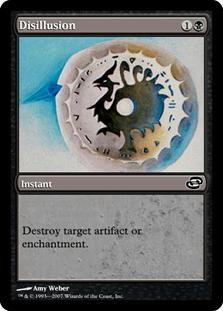
That card would do more damage to the game of Magic if it were printed than even Arcbound Ravager or Yawgmoth's Will. It may not be overpowered like the former are, but if any color could do anything without contracting out another color, then there would be no reason to play more than one color. It shores up two of the most blatant weaknesses of Black (Black can't destroy artifacts and/or enchantments).
An additional point to make about the color pie before I move on is the misuse of hybrid mana. Too often, someone posts a card like this:
Righteous Paladin – :1mana::symrw::symrw:
Creature – Human Knight (R)
Haste, first strike, lifelink
2/2
Haste makes no sense on a white card. Lifelink makes no sense on a red card. This card would make more sense if it cost . Before you slap a hybrid cost on a card and post it in the forums, ask yourself: “Does this card fit the color pie if I pay only mana of the first color?” “Does this card fit the color pie if I pay only mana of the second color?” If the answer to either of these is no, your card is better off simply being multicolored. And don’t even ask me about cards with three or more different hybrid symbols.
Using the Rarity System
The fourth thing that inexperienced card designers do is to assume that rarity is some kind of balancing scheme. For example, someone who has little experience designing cards would make a vertical cycle (A cycle that scales up by rarity) similar to this one. (For this example, assume Squire is common and Glory Seeker is uncommon.):
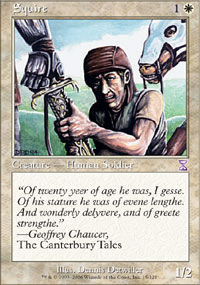

Snarling Lions –
Creature – Cat (R)
3/2
However, the first two cards are severely underpowered, and the latter is severely overpowered, being strictly better than Blade of the Sixth Pride. Whenever you assign rarity to a card, assume that any player can readily acquire four copies of that card. The only formats that should dictate the power of a card are Limited formats. If you do so, rarity becomes more of a complexity and power level issue, but only for limited. For example, if I had this card:
Cloud Warrior –
Creature – Faerie Warrior (U)
Flying
Cloud Warrior can only block creatures with flying.
2/1
This card can easily be common or uncommon, but I choose for it to be uncommon because it is a very fast card, and if I made it common, it would make Blue unbalanced in whatever set draft it is featured in. If you think of rares as a type of card you rarely get to see when opening packs, you can easily imagine three classes of cards that would be a good fit at rare: Cards that are too complex for uncommon and common and have no bearing on limited, cards that will see play in constructed but have no bearing on limited, and cards that would dominate limited. An example of each class, respectively:
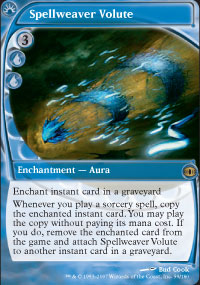
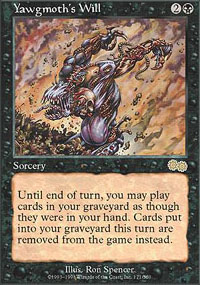

At common and uncommon, you mostly want filler cards. You want the cards that are variations of the main color pie abilities for each color. I consider cards such as Havenwood Wurm that will never be playable in constructed but round out your limited deck quite well to be filler. Overcosted, underpowered filler makes drafting no fun, but be careful not to make your filler too good.
Design For Innovation, Not Power

A future I would like,
but hardly anyone else does
After posting your cards, another thing to take consideration is criticism. I still get criticism to this day, because I often suggest things that other people might not like. For example, suggesting how Contraptions could be implemented is one of my most unpopular ideas. However, something I’ve seen way too often is that someone posts an overpowered card and in the face of criticism severely nerfs it, when a middle ground is more reasonable. For example, if someone posts:

If that person gets too much criticism that that card is too good in Standard, and replaces it with:
Bolt of Lightning –
Instant (C)
As an additional cost to play Bolt of Lightning, reveal your hand and remove all red cards in it from the game.
Bolt of Lightning deals 3 damage to target creature or player.
When something like this would do:
Bolt of Lightning –
Instant (C)
As an additional cost to play Bolt of Lightning, remove a red card in your hand from the game.
Bolt of Lightning deals 3 damage to target creature or player.
Before I wrap this thing up, I realize I have concentrated on the negatives, on “what not to do”. So here’s a tip to the aspiring card designer: Rules are meant to be broken. Future Sight is a prime example of R&D’s willingness to bend the rules, although they do it at a lower-profile level each and every set. However, don’t go to the rulebreaking well too often, or your rulebreaking will be considered less special and people won’t care about it. For example, Decimate is a card that breaks the rule of being too narrow. However, there is a cool factor that can't be denied. When it was first spoiled, I saw it and said "I can destroy an artifact, an enchantment, a creature, and a land all for :2mana::symr::symg:? Sweet!" But then I read that you have to make all four targets in order to play it. Not as great, but still cool in casual or multiplayer when the stars line up.
Finally, don’t feel too bad if you find out that you’re really good at one thing and absolute poo at other things. To this day I’m still not good at creating complex cards in the vein of Spellshift and Spellweaver Volute, and I have an absolute tough time with coming up with new mechanics. Don’t feel bad if it takes you a while to get into the groove of making simple yet interesting cards. I’ve been doing this thing for a while, and I flame out sometimes.
Class is dismissed for today. I hope to see your cards on the Custom Sets & Cards forums, and although I don’t give criticisms very often (because I am too busy making my own cards), sometimes I feel like giving pointers. I hope to see some interesting cards in your posts!
Comments